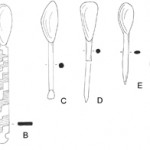As a former follower of Aelfric the Picky, I aspire to perfect representations of kit and costume. Being also though very much a fan of DAS’s informality and inclusivity I do not hold with rigid rules and regulations on what you must/must not have (or how much you must spend) to participate. I err on the side of “if it looks and feels right it’s good, lets have fun”!
The following is my guide to how to put together acceptable DAS banqueting kit. Of course, if you have time, money and inclination there are more serious replicas that can be bought or made. The scope is broad but if you find me on a Sunday morning modifying your multi-coloured car boot sale bargain goblet set with my sword pommel you will understand you have transgressed!
Basic kit should comprise (see minimum standards in the handbook) – Bowl, cup, spoon and knife. I will take these in turn giving background and practical suggestions.
Bowls and cups: One cup and two bowls are useful: drink/stew/extras – three medium sized bowls will do. Potential materials are wood, ceramic, soapstone, metal and horn. Wooden originals were in indigenous wood either pole-lathe turned or hewn/carved. Expect to pay about £5 – £20 for a wooden bowl in a ‘kitchen reject’ type shop.
Beware exotic woods – some woods (e.g. sandalwood) are aromatic and will taint food. Try craft fairs for hobbyist turners, I find telling them what we do gets a sympathetic discount to about £10 -£25 and offers to make stuff to order. There are currently some very nice carved bowls from Africa around, try Oxfam and other Trade Fair outlets (c.£12 up). Car boot sales turn up wooden bowls, watch out for cracks and prior use which may have tainted them and clean them thoroughly. Habitat sometimes has reasonable deals on the right stuff and check out their wooden spoons.
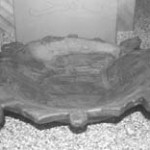

There used to be a fashion in DAS for ‘eating boards’. Simply a wooden board, these allowed messy stuff – candles, fish, butter, cheese, brisling, fnurd etc.- to be kept off the tables and was something to dramatically bang your knife into during ‘general shouting’. I had an 8″ x 18″ piece of 1″ thick beech for some years until someone gutted 50 trout on it then left it in chicken shit at West Stow, chiz, chiz. A simple bread board would do.
Wash wood as soon as you can after use, preferably without detergent, if necessary lightly scour and dry it thoroughly. A smear with vegetable oil should stop mould and cracks. If in doubt ask Anir for advice.
Ceramics were generally unglazed light coloured ware (grey or yellow fabric not red) hand raised or thrown on a medium to slow wheel. Decorated pots from our period, notably Badorf/Pingsdorf ware, were rare, very distinctive and best avoided. DAS has benefited from members making pots in the past, notably Godwin and Ulrik. Years ago, I did a couple of terms of night school where I made pots, some of which are still around. Trading these in DAS paid for the course and materials. If anyone is willing to take the challenge I can help with source material. Unglazed pots are porous so beware of bacterea, it is acceptable to glaze inside for health reasons (apparently in the USA it is illegal not to).
There are few modern substitutes which look absolutely right. There are some excellent handmade pots from Africa around in Oxfam, etc., at the moment. These are though (correctly) fired to a brittle fabric which does not lend itself to carting around to DAS halls. Some cheap aromatherapy lamps have a small cup of the right shape and texture.
There are some splendid examples of bronze and silver vessels from our period. As these were used to show off wealth and patronage of the arts, there are few ‘off the peg’ modern substitutes which will do. Please either keep it subtle (Anir’s bowl is an excellent example) or avoid. If using copper or brass be aware that, unless you have the guts of Beorn, verdigris is poisonous so clean well.
Soapstone is spot-on for Vikings. There are currently some simple soapstone bowls being imported from Nigeria. I am told by a geologist it is whiter & pinker than Northern European varieties, which have a grey/purple look, but, if chosen carefully, will pass. Prices are around £9 – £20 for a small bowl. Soapstone is porous and can leach heavy metals so do not leave acidic liquid standing for long.
Leather – apart from an interesting ceramic vessel moulded in the form of a leather bottle, there is little evidence for use of leather for cups etc.. In any case, the alternatives are so much more practical for our purposes. Best avoided. Natural horns are obvious drinking vessels and characteristic period pieces. Again, decorative horn mounts are distinctive so be careful. There is still absolutely no evidence of any sort for horn stands! Please care for your horn – recent advice (MAFF Sept. 1998) indicates there are no specific identified health risks from drinking horns. Periodically clean with a sterilising liquid – baby bottle stuff is ideal (alarm your friends – start browsing the supemarket baby section!), I am told Coca Cola does the trick but prefer something more controlled. Don’t use hot liquid in or on a horn, this can separate the layers and soaking can dissolve it – to make glue, boil horn! Fabricated horn cups etc. – again no evidence, best leave well alone.
Glass is again very distinctive. There was no glass manufacturing facility in England (there was re-cycling) until the tenth century. All vessels were imported and therefore expensive. Typical shapes are the ‘palm cup’ or ‘cone beaker’ neither of which stand up on their own so don’t lend themselves to modern decor. There are specialist re-enactment suppliers, see me for details! Some ‘close but no cigar’ items are in the Fair Trade shops at the moment – recycled glass has the right feel and subdued colours (amber, light blue or green) so keep looking.
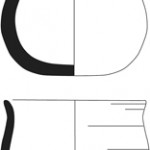
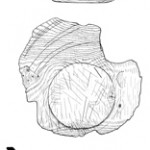

Knives:Archaeology reveals knives of different sizes and shapes. There are though two common features – single edge and no rivets. Blades are usually triangular section, straight edged and clipped back from the point. Handles can be wood, horn, antler or bone. As knives are essential I suggest the best readily available compromise is a small paring knife for about £1.50 – avoid ‘stay sharp’ serrated blades – I can tolerate ‘made in Sheffield’ and the brass rivets. Anir and others sometimes have excellent more accurate examples for sale, otherwise you will need to contact specialist re-enactment dealers at around £15 – £50. Unless taking part in a living history display do not wear or carry a sharp knife out of the hall, it can give the wrong impression. I have seen one snatched in fun on the assumption it was blunt with the intention of drawing it across the carriers throat!
The image shows various 9th-10th century knives at half size. A) 10th century blade from York and a 10th century bone handle from Carlisle. B) Complete 9th-10th century knife with wooden handle and brass suspension loop from Gotland. C) 10th century knife with bone handle from York. Note how the tang projects from either end; I reconstructed this with wooden caps to wedge the tang into and this held the knife together tightly. D) knife with wooden handle from York 10th century.
Spoons:Metal spoons have a distinct reversed bowl shape attached to a separately made handle which makes them awkward to represent. I have found pickle spoons and salad servers which look the part. Museum souvenir manufacturers make silver plated and pewter Roman spoons which are OK but rather small for most appetites. There are some copies of cast bronze examples at around £16. Horn spoons are not known from the archaeology. Bone spoons tend to be small due to the nature of the raw material. Wooden spoons, where found, are hand carved and often decorated. A cheap modern wooden kitchen spoon, subtly altered to disguise its machine made origin has always been the most effective DAS solution.
The image shows various 9th-10th century spoons at 1:3. A) and B) wooden spoons; York 10th-11th century. C) bone spoon from York; 10th century. D) and E) bone spoons from Thetford; 9th-10th century. F) Iron double spoon with tin coating; York 10th century. G) Suggested modification of baking type shop bought spoon; cut of the end with a hole in and scrape down the handle and bowl to give it a more faceted look; rather than machine made smooth surfaces.

Jugs: See pottery. To be encouraged as they help keep cans and bottles out of the way. Choose the shape and colour carefully.
Lighting: For our period there is evidence for beeswax, tallow and oil for lighting. King Alfred is credited with the invention of a candle clock and apparently candles made from lumps of wax (ie. not dipped) have been found in Dublin and Scandinavia. I have never investigated this evidence personally but it is good enough for me. There are though no candlesticks, instead bowl shaped lamps have been found and illustrated. These were free standing, wall mounted or suspended (see Ulrik’s old DASMAG article). There are also ‘prickerts’ or spikes for sticking candles on. Safety issues involving naked flames dictate we should avoid oil lamps and use candles in secure holders, a small bowl is useful. Please provide a candle holder as it helps clear up afterwards if there aren’t great gobbets of wax on the tabletops.
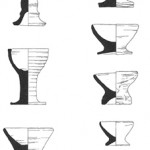
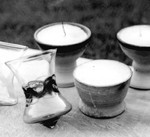
The image shows a photo of my own glass drinking cups and pottery candle holders; these can be bought from Murton park, me or even hand made by yourself. You can buy air clay in a yellow/grey colour in “the Works” for a few quid and have a go, it doesn`t need firing and is reasonably easy. See right for different shapes.
Table cloths: Packs should provide a table covering for pragmatic reasons. They avoid the shiny melamine experience, help clear up and stop potential damage to table tops. They are illustrated in Anglo-Saxon contexts. Calico curtain lining or polycotton sheeting should last at least a season and be reasonably cheap. Hot wash after use!
Some definate no-no’s: Daggers, tankards, quaiches, glazed ceramics, most goblets and almost anything from a shoppe called ‘Ye Olde ….’.
Warning: Remember you will have to transport all this. I have broken four glass vessels, one hand made pottery jug, three pottery cups and two pottery lamps in transit to events.
Naming: Eating kit is the most common lost property group. Carve or paint your DAS name or appropriate sign on your stuff, it then stands a good chance of finding it’s way back to you.
Conclusion: Eating stuff from our period is distinctive. With thought there are though modern items which will do. Care should be taken selecting items to avoid making the table look and feel wrong. A probationary/full member is expected to have: Two wooden bowls, a wooden spoon and a knife. You ought to be able to buy acceptable examples of these new in a lunchtime for under £20.
